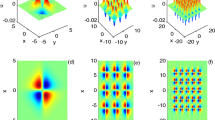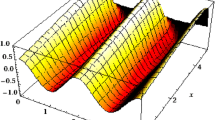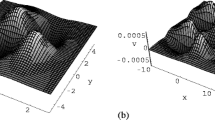Abstract
As one kind of Burgers-type equation, the extended coupled (2+1)-dimensional Burgers system is used to describe certain wave process in oceanography, acoustics or hydrodynamics. With the Riccati projective equation method and symbolic computation, the variable separation solution is derived. Due to the arbitrary functions in the variable separation solutions, the fractal and chaotic structures are studied based on the gradient function (say, U in the text). Some excitation properties of the solutions are analyzed and figures are plotted to show the shape and the structure.











Similar content being viewed by others
Data availability
All data generated or analyzed during this study are included in this published article.
References
Hirota, R.: The direct method in soliton theory. Cambridge University Press, Cambridge (2004)
Lü, X., Hui, H.W., Liu, F.F., Bai, Y.L.: Stability and optimal control strategies for a novel epidemic model of COVID-19. Nonlinear Dyn. 106, 1491–1507 (2021)
Fan, E.G., Zhang, H.Q.: A note on the homogeneous balance method. Phys. Lett. A 246(5), 403–406 (1998)
Lü, X., Chen, S.J.: New general interaction solutions to the KPI equation via optional decoupling condition approach. Commun. Nonlinear Sci. Numer. Simul. 103, 105939 (2021)
Zhang, Z.Y., Huang, J.H., Zhong, J., Dou, S.S., Liu, J., Peng, D., Gao, T.: The extended (g’/g)-expansion method and travelling wave solutions for the perturbed nonlinear Schrdinger’s equation with kerr law nonlinearity. Pramana 82(6), 1011–1029 (2014)
Yin, M.Z., Zhu, Q.W., Lü, X.: Parameter estimation of the incubation period of COVID-19 based on the doubly interval-censored data model. Nonlinear Dyn. 106, 1347–1358 (2021)
Chen, S.J., Lü, X., Li, M.G., Wang, F.: Derivation and simulation of the M-lump solutions to two (2+1)-dimensional nonlinear equations. Physica Scripta 96, 095201 (2021)
Xu, J.Z., Huang, J.N.: Bell-shape soliton pair in a hydrogen-bonded chain with asymmetric double-well potential. Phys. Lett. A 197(2), 127–134 (1995)
Li, J.B., Zhang, Y.: Bifurcations and parametric representations of traveling wave solutions for the (2+1)-dimensional Boiti-Leon-Pempinelle system. Math. Methods Appl. Sci. 34(2), 147–151 (2011)
Yin, Y.H., Chen, S.J., Lü, X.: Localized characteristics of lump and interaction solutions to two extended Jimbo-Miwa equations. Chin. Phys. B 29, 120502 (2020)
Chen, S.J., Lü, X., Li, M.G., Wang, F.: Derivation and simulation of the M-lump solutions to two (2+1)-dimensional nonlinear equations. Physica Scripta 96, 095201 (2021)
Lü, X., Chen, S.J.: Interaction solutions to nonlinear partial differential equations via Hirota bilinear forms: one-lump-multi-stripe and one-lump-multi-soliton types. Nonlinear Dyn. 103, 947–977 (2020)
Chen, S.J., Lü, X., Tang, X.F.: Novel evolutionary behaviors of the mixed solutions to a generalized Burgers equation with variable coefficients. Commun. Nonlinear Sci. Numer. Simul. 95, 105628 (2021)
Gleick, J., Hilborn, R.C.: Chaos: making a new science. Phys. Today 41(11), 79 (1988)
Lü, X., Hua, Y.F., Chen, S.J., Tang, X.F.: Integrability characteristics of a novel (2+1)-dimensional nonlinear model: Painlevé analysis, soliton solutions, Bäcklund transformation, Lax pair and infinitely many conservation laws. Commun. Nonlinear Sci. Numer. Simul. 95, 105612 (2021)
Mandelbrot, B.B.: The fractal geometry of nature. Am. J. Phys. 51(3), 468 (1998)
Falconer and Kenneth. Fractal geometry: mathematical foundations and applications, second edition. Biometrics, 46(3), (2020)
Wiggins, S.: Global bifurcations and chaos analytical methods. Springer-Verlag, Berlin (1988)
Dai, C.Q., Wang, Y.Y., Zhang, J.F.: Managements of scalar and vector rogue waves in a partially nonlocal nonlinear medium with linear and harmonic potentials. Nonlinear Dyn. 102, 379–391 (2020)
Burgers, J.M.: A mathematical model illustrating the theory of turbulence. Adv. Appl. Mech. 1, 171–199 (1948)
Bateman, H.: Some recent researches on the motion of fluids. Mon. Weather Rev. 43(4), 163 (1915)
Dai, C.Q., Wang, Y.Y., Fan, Y., Yu, D.G.: Reconstruction of stability for Gaussian spatial solitons in quintic-septimal nonlinear materials under PT-symmetric potentials. Nonlinear Dyn. 92, 1351–1358 (2018)
Osman, M.S., Baleanu, D., Adem, A.R., Hosseini, K., Eslami, M.: Double-wave solutions and lie symmetry analysis to the (2+1)-dimensional coupled Burgers equations. Chin. J. Phys. 63, 122–129 (2020)
Wazwaz, A.M.: Multiple-front solutions for the burgers equation and the coupled Burgers equations. Appl. Math. Comput. 190(2), 1198–1206 (2007)
Dai, C.Q., Wang, Y.Y.: Coupled spatial periodic waves and solitons in the photovoltaic photorefractive crystals. Nonlinear Dyn. 102, 1733–1741 (2020)
Wang, G.W., Fakhar, K., Kara, A.H.: Soliton solutions and group analysis of a new coupled (\(2+1\))-dimensional Burgers equations. Acta Physica Polonica 46(5), 923 (2015)
Wang, J.Y., Liang, Z.F., Tang, X.Y.: Infinitely many generalized symmetries and painlevé analysis of a (2+1)-dimensional Burgers system. Physica Scripta 89(2), 025201 (2014)
Motsepa, T., Khalique, C.M.: Conservation laws and solutions of a generalized coupled (2+1)-dimensional Burgers system. Comput. Math. Appl. 74(6), 1333–1339 (2017)
Lü, J.H., Chen, G.R., Cheng, D.Z.: A new chaotic system and beyond: the generalized lorenz-like system. Int. J. Bifurc. Chaos 14(05), 1507–1537 (2004)
Acknowledgements
This work is supported by the Fundamental Research Funds for the Central Universities of China (2018RC031), and the National Natural Science Foundation of China under Grant No. 71971015. Y.W. Zhao and J.W. Xia are supported by the Project of National Training Program of Innovation and Entrepreneurship for Undergraduates under Grant No. 201910004054.
Author information
Authors and Affiliations
Corresponding author
Ethics declarations
Conflict of interest
The authors declare that they have no conflict of interest concerning the publication of this manuscript.
Additional information
Publisher's Note
Springer Nature remains neutral with regard to jurisdictional claims in published maps and institutional affiliations.
Appendix I
Appendix I
In Eq. (1), we assume that
where \(\alpha ,~\beta \) are positive integers and
are analytic functions of (x, y, t) near a singularity manifold \(M=\{(x,y,t):\psi (x,y,t)=0\}\).
To balance the dominant terms, we assume the leading order singular behavior is in the form of
and obtain
We directly substitute
into Eq. (1), and make the determinant of the coefficients on \(u_{j},~v_{j}\) in the lowest order system of Eq. (1) with respect to \(\psi \) to zero, leading to
Solving Eq. (47) gives the resonance values as
\(j=-1\) corresponds to the arbitrary singular manifold. From the coefficients of \((\psi ^{-3},\psi ^{-3})\), \((\psi ^{-2},\psi ^{-2})\), \((\psi ^{-1},\psi ^{-1})\) and \((\psi ^{0},\psi ^{0})\), we can show that either \(u_{1}\) or \(v_{1}\), \(u_{2}\) or \(v_{2}\), \(u_{3}\) or \(v_{3}\) and \(u_{4}\) or \(v_{4}\) is arbitrary. Thus, we can conclude that Eq. (1) possesses the Painlevé property.
Rights and permissions
About this article
Cite this article
Zhao, YW., Xia, JW. & Lü, X. The variable separation solution, fractal and chaos in an extended coupled (2+1)-dimensional Burgers system. Nonlinear Dyn 108, 4195–4205 (2022). https://doi.org/10.1007/s11071-021-07100-z
Received:
Accepted:
Published:
Issue Date:
DOI: https://doi.org/10.1007/s11071-021-07100-z




